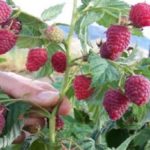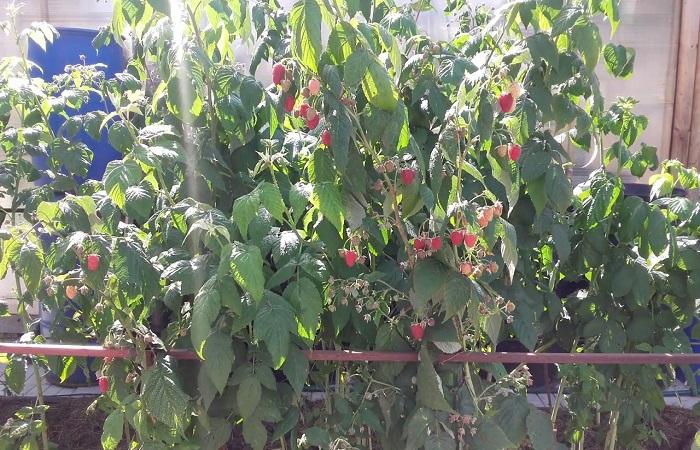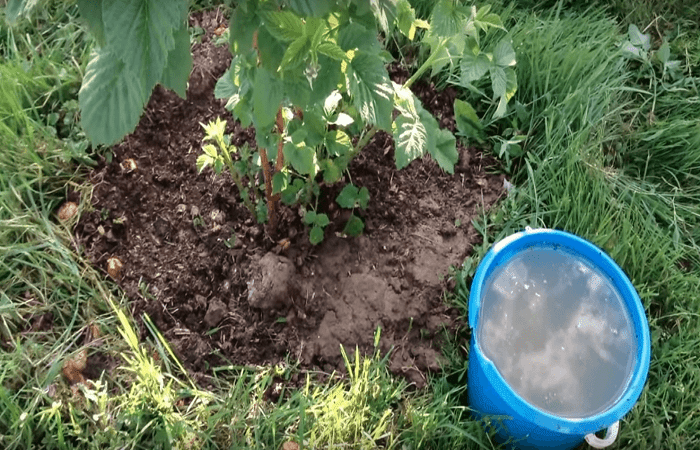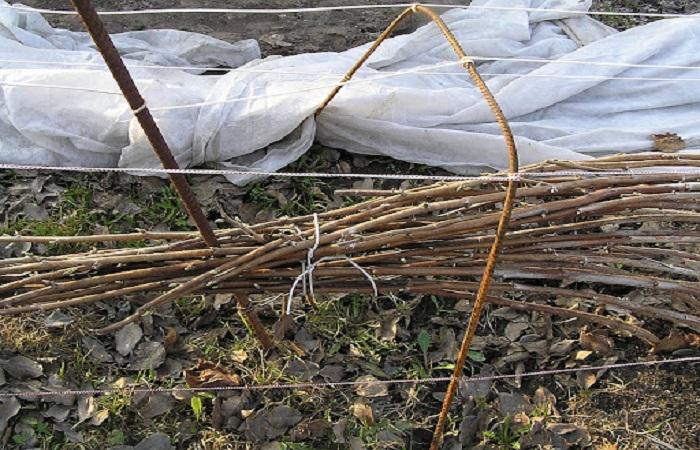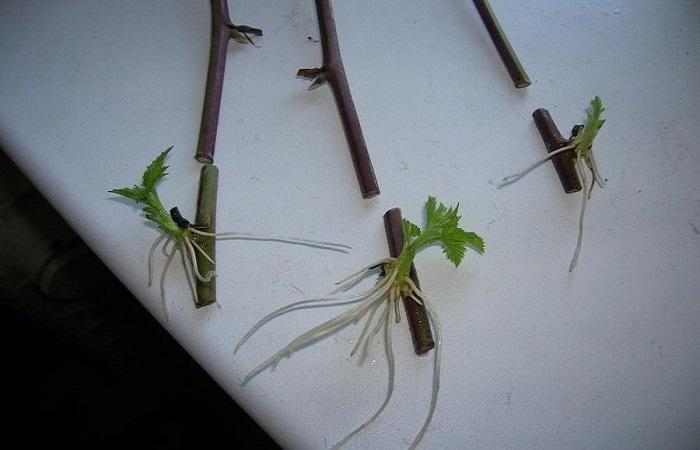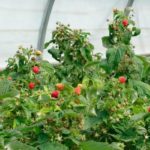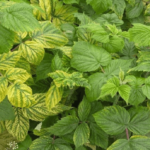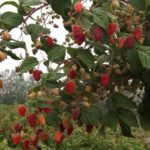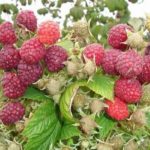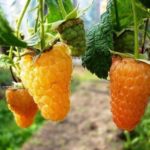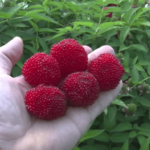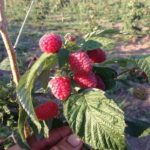Among the fruitful new berries, Monomakh's Cap, a remontant raspberry variety, bred by Russian scientists more than 10 years ago, stands out. Currently, the new variety of berry crop is not registered in the registers and has been withdrawn from varietal testing. But gardeners and gardeners take great pleasure in growing large and tasty raspberries in their garden plots. We’ll find out in more detail below why we love this new crop and how to get a harvest of juicy and healthy berries.
Description and characteristics of raspberries Monomakh's Cap
The plant is characterized by small, compact bushes, reaching no more than 1.5 m during the growing season.
- The bush is formed from 4-5 powerful, spreading and branching shoots of a bright emerald hue.
- During the growth process, hard and sharp purple thorns are formed on the branches of the plant, located in the lower part of the bush.
- The leaf blades are characteristic of a berry crop; the upper part of the blade is bright green, the back side of the leaves is whitish.
- During the flowering period, racemose inflorescences form on the shoots, in which fruit ovaries appear after the end of flowering.
- The variety is capable of self-pollination, but to increase fruiting, neighbors with similar flowering periods are recommended.
- The ripening of berries depends on the weather conditions of the growing region. In southern climates, the berries are harvested in early August. In temperate latitudes, fruit ripening occurs 2-3 weeks later. In the northern regions, Monomakh's Cap does not have time to ripen in open ground, so it is recommended for cultivation in greenhouse conditions.
- Raspberries of this variety are remontant; in the southern sun they manage to produce 2 harvests per season. If summer berries ripen on the shoots of the previous year, autumn fruits, larger, ripen on young branches.
- The berries are bright red, cone-shaped, with an average weight of 12 to 15 g; there are specimens up to 20 g.
- With proper and timely care, each plant produces up to 7 kilograms of tasty, sweet and juicy fruits.
- The berries are dense, not prone to falling or cracking, and can easily be transported and stored.
- The taste of the fruit is sweet, with slight sourness and small drupes. The berries are consumed fresh or used for various preparations.
Important! From the mother varieties, the raspberry Monomakh's Cap received excellent resistance to weather changes and frosts.
Advantages and disadvantages
To grow healthy, fruit-bearing berry bushes, you need to find out all the pros and cons of the plant.
Advantages:
- universal purpose of berries;
- stable, annual fruiting, high yields;
- large size and excellent taste characteristics of ripened fruits;
- manifestation of repair abilities;
- high frost resistance, plants tolerate short frosts down to -25 degrees;
- long-term storage and the possibility of long-distance transportation of the harvested crop.
Flaws:
- weak natural immunity to diseases and harmful insects;
- inability to grow raspberries in cold climates;
- pickiness of the variety to the composition of the soil.
Important! Raspberry Monomakh prefers fertile soil with low levels of acids. Otherwise, the berry bushes stop growing and developing.
Specifics of growing the variety
Varietal raspberry seedlings are purchased from nurseries or garden centers. Plants are inspected for lesions and damage. To grow raspberries, choose flat, well-lit areas of land, protected from gusty winds and drafts.
- The soil is carefully dug up to a depth of 25 cm and loosened.
- Depending on the composition of the soil, organic and mineral elements are added.
- The presence of groundwater is allowed at a level not higher than 1.5 m from the ground surface.
- 2-3 weeks before planting, holes up to 35-40 cm deep are dug in the prepared area.
- The distance between seedlings is kept within 1-1.5 m, between rows - up to 2 m.
- A drainage layer of small stone is laid at the bottom of the hole, and fertile soil is poured on top.
- A seedling is placed on top of the mound, the rhizomes are carefully straightened and dug in to the root collar.
Advice! To provide the necessary soil moisture and eliminate weeds, the soil under the plants is mulched with dry grass or wet sawdust.
Subtleties of caring for raspberries
In the first season of growth and development, seedlings have enough nutrients added to the soil during planting. Next, the bushes require abundant watering, fertilizing and timely pruning to normalize fruiting.
Top dressing
Caring for a remontant crop is not difficult. Organic and mineral fertilizers are used to feed berry bushes:
- in spring and early summer, raspberries are fed with nitrogen-containing organic matter, which helps the growth and development of the green cover of the bushes;
- at the moment of ovary formation and fruit ripening, a balanced mineral complex based on potassium and phosphorus is added to the soil;
- In the process of preparing plants for winter rest, the bushes are fertilized with organic and mineral additives.
Advice! It is best to combine work on feeding raspberries with watering and weeding.
Watering and loosening
The quality and taste of ripening berries depends on proper watering. With a lack of moisture, the fruits become smaller. Irrigation of the bushes is carried out in the morning or evening, pouring up to 20 liters of moisture under each plant. In southern latitudes, raspberries are watered 3-4 times a month; during drought, the amount of irrigation is doubled.
Trimming
Pruning of bushes is carried out after harvesting or in the spring, before the buds open. Remove all dry, old, broken and damaged branches. In case of possible frosts, the plants are completely pruned.
Wintering
In the southern climate, Monomakh's Cap raspberries do not require additional insulation for the winter. In other cases, trimmed bushes are covered with a thick layer of humus, spruce branches or dry leaves.
Reproduction
The varietal crop is propagated by cuttings and layering. Cuttings are cut from adult bushes, the tips are treated with a growth stimulator and placed in a container with water. After the roots appear, the seedlings are planted in fertile soil, and in the spring they are transferred to a permanent place of growth.
Protecting plants from diseases and pests
The raspberry variety Monomakh's Cap is susceptible to various fungal, viral and bacterial diseases. In order not to lose the harvest and keep the plants healthy, the bushes are treated with fungicides annually. Harmful insects are dealt with using biological or chemical drugs, as well as traditional methods.
Harvest and storage
Ripe berries are easily separated from the stalk. The harvested crop is placed in specially prepared containers and sent for storage or processing. Raspberries can be stored in the refrigerator for up to 6 days.
The berries are used to make jam, juices and nectars, and added to desserts and baked goods. Large fruits are also frozen and dried.


